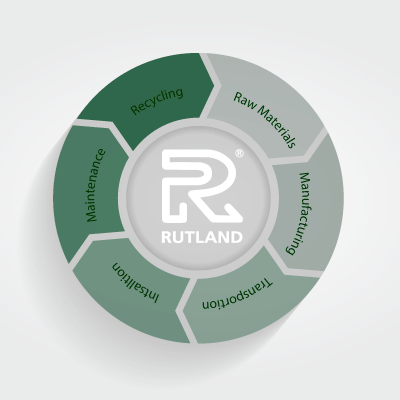
Rutland is committed to continual improvement in reducing the environmental cost of all our activities and products. As part of this, we routinely evaluate the environmental impacts of our door closers, with the help of independent third-party and internal data. This is known as Life-Cycle-Analysis, which forms the basis of the final Environmental Product Declaration, or EPD for short.
The resulting Environmental Product Declaration (EPD) enables specifiers and architects to calculate the embodied environmental impacts that their choice of door closer devices might have. Architects and civil engineers use the EPD of components to help calculate the embodied carbon of a building.
The EPD expresses the Global Warming Potential in a product's life as CO2 equivalent units. In addition to designers, it also aids those with influence over the product's use and eventual replacement in making choices about maintenance, renewal, and end-of-life recycling.

An Environmental Product Declaration is a document drawn up by the product’s manufacturer to specify the environmental impact of the product, ideally from raw material extraction through delivery, installation, maintenance, and end-of-life recycling or disposal options. The International ISO standard 14020:2022 deals with self-declared Type II EPD certificates and ISO 14025 Type III EPD certificates.
Both Type II and III EPDs are drawn up on the basis of a Life Cycle Analysis (LCA) of the product. ISO 14040:2006 covers the principles of the LCA and provides a general framework.
The main difference between the two types of EPDs are that type II is self-certified and type III is independently certified by an approved third-party.
The LCA is split into the different life stages of the product, for example:
In the case of Door Closers it is mostly steel, aluminum,brass or zinc alloy, with small amounts of nylon, plastic, rubber etc. Whether the materials are extracted or recycled is taken into account when assessing Global Warming Potential (GWP).
This assesses the GWP of the transportation of raw materials and semi-finished products to the point of being available as finished a product, promoting short and environmentally friendly transportation routes.
- Transport from gate to site
- Assembly/installation
This LCA stage of any product potentially involves the day-to-day energy use, repairs, servicing, water use etc. In the case of manually-operated door closers, there is low GWP during B1 - B7 so the longer the closer remains functional and compliant the lower the lifetime GWP. EN 1154 closers are lab-tested to 500,000 cycles.
- Deconstruction/removal
- Transport
- Waste Processing
- Disposal
Compared with landfill, this is the preferred option where facilities allow. Some manufacturers, such as Rutland Door Controls operate take-back facilities for end-of-life recycling.
The internationally recognised EPD standards aim to enable an open, fair, and transparent way to calculate a building project’s total environmental cost by adding up the impact of every component. This allows informed sustainable choices to be made when comparing construction products and design approaches, which are quantifiable by globally recognised technical standards.
The A1-A3 (product stage) GWP (Global Warming Potential) of a Rutland door closer, as defined in BS EN 15804 is:
EPD = 3.09E+01 kg CO₂ eq
This is the GWP (Global Warming Potential) of placing 1kg of Rutland door closer on the market. Along with the weight of the door closer model, this figure can be used to compare product options and be included in a new building or refurbishment project's GWP calculations.
The future product life-cycle data (A4 - C4) has to be based on some established assumptions and averages, which are explained within the EPD report. The main purpose of the EPD scheme is to enable like-for-like comparisons to encourage climate-friendly development. Adjustments from the given assumptions can be made to create a more accurate total GWP calculation.
Awareness of the environmental impact of each stage of a product’s life cycle also allows our in-house innovation team to keep challenging where and how improvements can be made.
Every small step-by-step change we make to either our products or processes adds up over time. During 2024, the use of plastic in our packaging is to be further reduced following research work undertaken during 2023.
Also in 2023, Rutland launched an end-of-life take-back scheme for door closers. This scheme aims to increase the amount of recycling and upcycling opportunities door closing devices, as this is shown by the closer’s EPD to be the most sustainable route to take.
In the case of mechanical hydraulic door closers, there are no direct energy costs to consider during use. This makes the inspection and servicing of closers (a legal requirement in many cases) the main activity to take into account when declaring a system’s sustainability level during the in-use stage.
With the manufacturing, transport to site, installation, and end-of-life (environmental) costs minimised, the next most important consideration is the length of service life. A closer that lasts twice as long, presents a scenario of half the environmental impact in its Lifetime Cycle Impact Assessment. To this end, Rutland builds their closers to last 5 - 35 years in operation, as shown by their industry-leading guarantees.
The choices we all make today, impact the world we and our children will live in. Through actions large and small, let's give our planet the best chance to survive and thrive.
Leave us your contact details and we will call you back for a free consultation about your requirements.